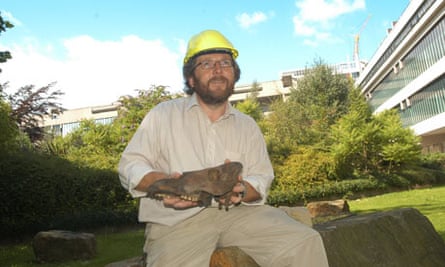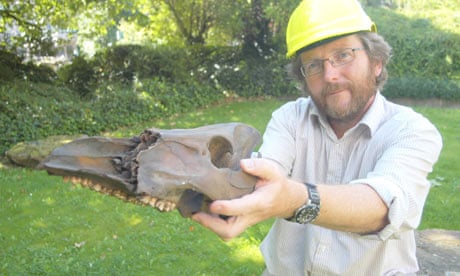Suggest to the average Yorkshireman that hippos and other exotic creatures perhaps more suited to a Doug McClure film once roamed the streets of Leeds, albeit thousands of years before the likes of Harvey Nichols and Marks and Spencer flanked such, and your sanity might be politely called into question.
But perhaps astonishingly, just over 150 years ago, in 1851, workmen digging clay in a brick field in Wortley, Leeds, discovered several huge bones, so large that it was thought they 'could not be Christians' bones'.
As a result, the finds were brought to the attention of Henry Denny, curator of the Leeds Philosophical and Literary Society Museum.
Denny identified them as the bones, quite remarkably, of the Great Northern Hippopotamus, which flourished over 100,000 years ago.
Roaming near Armley Gyratory
Quite how creatures more suited to far more temperate climes came to be in proto-Leeds has been the passionate quest of many Yorkshire scientists, geologists and botanists since that early discovery.
Although a number of small bones were destroyed before the unearthing of the massive thigh bones, Henry Denny gathered numerous bones and teeth which enabled him to identify the animals.
Closer examination proved them to be the part remains of three hippopotami - an aged individual and two adults - an elephant and an auroch (extinct wild ox).
Later research identified the animals as Hippopotamus amphibius, Elephas primigenius and Bos primigenius.
It's thought they once roamed in the area close to Armley Gyratory, one of the busiest road intersections on the outskirts of the present day city.
The bones were scientifically dated using a sample from a molar tooth. The 'Leeds Hippo' was found to date from around 113,000-130,000 years ago, at the time of the last 'interglacial', the warmer periods between the cycle of ice ages.
How could Leeds support such creatures?

But how and why could the climate of now-chilly Yorkshire have supported creatures more suited to warmer climes?
Phil Murphy, from the University of Leeds' School of Earth and Environment, says the climate of Yorkshire was very different years ago.
"There have always been concerns about the dating of these bones. Denny recorded that they were all discovered within a small area and that some were still articulated. He concluded that the bodies had not travelled far after death.
"A workman told T. P. Teale, who went to the site with Denny, that querns had been found in an adjoining field at about the same level. He wrote a paper suggesting that the animals were alive after the last glaciation and possibly during roman times.
"To resolve these queries, an adult femur was selected for dating at the Scottish Universities Research and Reactor Centre in 1975. Three methods were used and gave similar results of around 30,000 BP (radiocarbon years before present).
"These results were completely unexpected as the dates fell within the Middle Devensian. Pollen and insect remains had shown that at this time the environment in England was tundra conditions in which the hippopotamus could not live.
"It was suggested that, at the time of the discovery, it was the practice to coat bones with gelatine. Gelatine, being carbon-based, would introduce contamination of younger radioactive carbon into the sample, thus giving an erroneous result.
"An attempt to resolve this problem was made using a molar tooth. It was hoped that material from the centre would not be contaminated.
"An age of greater than 40,000 BP (radiocarbon years before present) was determined - so it is older than the maximum date you can get with that radiocarbon dating can pinpoint for bone.
"The Hippo was thus shown to belong to the last (Ipswichian) interglacial (130,000 - 117,000 BP) when we are almost certain there would have been no humans around in this area."
A different Leeds
Murphy said Leeds would have been very different during those times. He added:
"Leeds would have been just like Africa in those days – and the climate would have been exactly the same as hippos enjoy in that continent today, in the so-called Ipswichian interglacial.
"Hyenas were also around at the time and hyena dens have been found in Victoria Cave near Settle in Yorkshire and Kirkdale Cave on the N Yorkshire Moors.
"But it is important to remember that during the last glacial period, the glaciers did not reach Leeds.
"The earth has experienced some 24 periods of cooling and warming over the last 2.5m years."Will it happen again? Almost certainly, and if it is warm enough in Leeds in the future, the Hippos will return."
DNA analysis has shown that modern humans arrived in Britain before the last glacial period but retreated to Southern Europe when much of Britain was ice covered, with the remainder being tundra.
Closest living relatives 'are cetaceans'
Until 1985, naturalists grouped hippos with pigs, based on molar patterns.
However, several lines of evidence, first from blood proteins, then from molecular systematics and DNA (and the fossil record), show that their closest living relatives are cetaceans – whales, dolphins and porpoises.
The most recent theory of the origins of Hippopotamidae suggests that hippos and whales shared a common semi-aquatic ancestor that branched off from other artiodactyls [camels, cows, pigs etc] around 60 million years ago. This hypothesized ancestral group likely split into two branches around 54 million years ago.
One branch would evolve into cetaceans, possibly beginning about 52 million years ago with the proto-whale Pakicetus and other early whale ancestors collectively known as Archaeoceti, which eventually underwent aquatic adaptation.
The earliest evidence of human interaction with hippos comes from butchery cut marks upon hippo bones at Bouri Formation dated around 160,000 years ago.
Later rock paintings and engravings showing hippos being hunted have been found in the mountains of the central Sahara dated 4,000–5,000 years ago near Djanet in the Tassili n'Ajjer Mountains.
Hippos were also well-known to the ancient Egyptians, where the hippo was recognized as a ferocious denizen of the Nile.
In Egyptian mythology, the hippopotamus-headed Tawaret was a goddess of protection in pregnancy and childbirth, because ancient Egyptians recognized the protective nature of a female hippopotamus toward her young
The hippopotamus has been known to historians since classical antiquity.
The Greek historian Herodotus described the hippopotamus in The Histories (written circa 440 BC) and the Roman Historian Pliny the Elder wrote about the hippopotamus in his encyclopedia Naturalis Historia (written circa 77 AD).
The bones can now be found at Leeds City Museum in Millennium Square where they are one of the key exhibits.
More about the Hippos can be found at the Leeds Geological Association website, which has the hippo as it emblem, or at the Leeds City Museum.
What do you think? Have your say in the comments section below.
Guest blogger Martin Hickes is a Leeds-based freelance journalist.

Comments (…)
Sign in or create your Guardian account to join the discussion